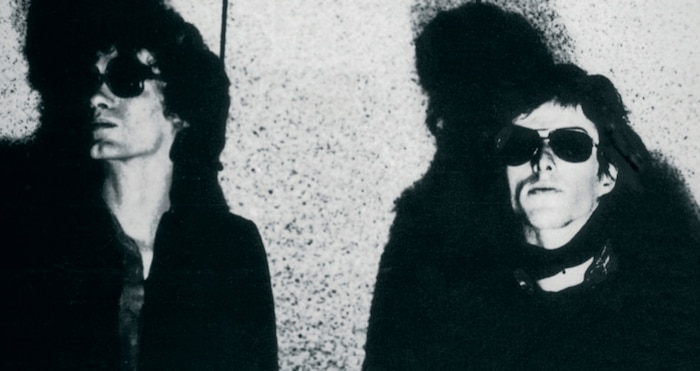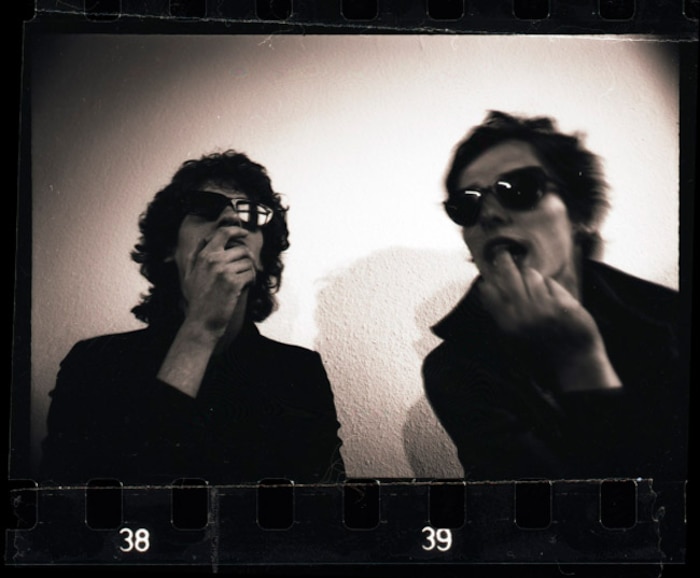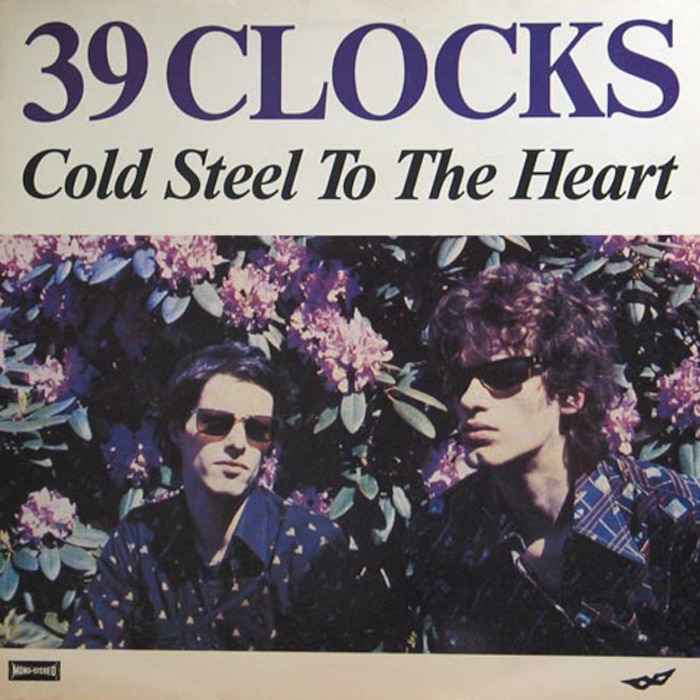Interview: 39 Clocks’ Jurgen Gleue on Psycho Beat and Out-Punking The Punks in ’80s Germany
Based in Hannover, a river city in the north of Germany and a gateway to several of the country's river valleys, post-punkers 39 Clocks, AKA the duo of JG39 (AKA Jurgen Gleue) and CH39 (AKA Christian Henjes), existed under the critical radar for much of their time together. Far removed from any potential peers, 39 Clocks harbored a philosophical position just shy of absolute misanthropy, often purposefully alienating themselves from all that surrounded.

Unlike other German post-punk acts like Einstürzende Neubauten and Liaisons Dangereuses, who went on to some degree of international infamy partly through their allegiance with loosely-defined movements like the Neue Deutsche Welle, 39 Clocks were out on their own, self-marginalized through their antisocial take on music-making. Dressed in black, perpetually wrapped in shades, and often appearing close to absolute lethargy, they took on the world the only way they really knew how – with a disaffected shrug and cold, joker’s rictus.
Behind the masks, though, were two songwriters of unique voice, who somehow managed to lift the best lessons from the Velvet Underground, ’60s freakbeat music, psychotic garage moves and outsider rock mythology, creating an entirely idiosyncratic, cracked vision of what popular song could communicate. They sometimes called this aesthetic, with perfect brevity and wit, “Psycho Beat.” All the while, 39 Clocks kept on the move, changing shape, leaving behind a breadcrumb trail equal parts fact and fiction.
Unsurprisingly, their legend has grown almost by stealth, with artists as diverse as American psych artist Ben Chasny (Six Organs Of Admittance) and techno producer Silent Servant big fans. You can also hear their influence in German psych groups like PLO and Floating Di Morel. But with myth seemingly inseparable from reality, the current wave of interest in 39 Clocks, from De Stijl’s Zoned compilation to the various recent reissues of their first two albums, Pain It Dark and Subnarcotic 39 Clocks, begs the question: What exactly is the real story of the 39 Clocks?
We checked in with one half of the duo, JG39, to talk about the group's mysterious “career” and why it all ended. Thorough and droll in his responses, Gleue was happy enough to correspond over email about the group.
Can you tell me about the start of 39 Clocks, and how you met Christian Henjes?
Meeting the other guy in the Clocks goes back to the mid-’60s: Same school, same neighbourhood, similar interests, doing drawings, comics, (and later) music (kind of terrorizing the neighbours… there were lots of complaints), crappy Super 8 home movies, drinks and drugs. This wasn’t at all ambitious or taken very seriously and was just stuff to entertain ourselves. So we did music throughout the ’70s under different names. Christian and me and different drummers or bass players from time to time…
So that was the pre-history of 39 Clocks.
Yeah, this was all the same band, and went on throughout the ’70s. We played/rehearsed at various locations like in the basement of this church center located next to a graveyard, so in a way we played right next to those corpses. We’d do acid there and did long monotonous repetitive guitar things, no vocals. Not that great, really; but fun.
A lot of people in the late ’70s thought we sucked or were just a laugh, especially “real musician” types. Quite a few changed their tune when the records came out and got all kinds of cool reviews.
With early punk, bands had the image of not playing that well in a “proper musician” (non)sense, and we went, “Hey, we can’t, too, so…” And although a lot of punks (not all) hated us, the early punk thing was inspiring as it got us into short up-tempo songs with cynical or silly words. Also, possibilities for live shows opened up. [At the] first gig in 1977 we had a vacuum cleaner on stage, dropped acid, forgot all our short new punk songs, and didn’t care about them anymore and just did noise improvisation. We had a guy dressed as a mummy lying in the doorway and some sick people kicked him right in the stomach. That was local artist Bruno Hoffmann, who “managed” us for a while (got us gigs), because as he claimed, “We were the worst band he ever heard.” He liked to tell this to his artist friends when we were around. He knew we thought this was very funny. Bruno used to wear a white painted jacket, which was really stiff from thick paint. I used to wonder how he got into that…
I remember he once got us a gig in a stone canyon, a quarry, where art students projected huge pictures onto the stone walls. Quite beautiful, really. We carried our amps knee-deep through this swamp-like ground. They had a generator for electricity and a wooden improvised stage. Then he got us on the Documenta art show in Kassel, except the Documenta people didn’t seem to know much about it. Or maybe, rather, didn’t want to know. Joseph Beuys definitely wasn’t that excited about it.
A lot of people in the late ’70s thought we sucked or were just a laugh, especially “real musician” types. Quite a few changed their tune when the records came out and got all kinds of cool reviews. So really the records made all the difference.

What was the general cultural climate?
Hannover was a typical big northern German town, nothing special, boring. Even Karl Marx (like everybody else) thought so. Despite that, I’m sure it had a huge impact on our output. There’s a vague cold, detached, unfriendly vibe around here which I think reflects in the words and music, but there’s also an overriding feel of mediocrity. Very mundane. Someone here put out some compilation LPs called From the Middle of Nowhere for a reason. We started out in the suburbs which was even worse. If you didn’t come up with something on your own, one could easily get sucked into this nothing place void – but then nothingness has this Zen-type paradox thing and stuff can evolve from it.
A real big thing for me was the biggest German publisher of trash comics in the ’50s and ’60s was located in Hannover, when comic books were just one step above porn and sort of seen as subversive.
Famous Dadaist Kurt Schwitters was from here as was John Kay, the singer with Steppenwolf who went to school in Hannover before he went to Canada and the US. Strangely this was the first live band I saw in ‘69 ( I was 14 then) when they were huge, around the time of “Magic Carpet Ride.” They still had a psychedelic thing in there. Also Kay was constantly wearing dark shades like we did, later on. A real big thing for me (but no one else here) was the biggest German publisher of trash comics in the ’50s and ’60s was located here, when comic books were just one step above porn and sort of seen as subversive. The interesting thing was that these comics weren’t just foreign imports but also locally produced/drawn product. It was kids’ stuff but had great trashy flair. Comic shops at that time were these great rotten shabby makeshift places with, again, incredible cool flair.
Who else was around, what other musicians you were connected to? I’ve always sensed that, apart from people like Floating Di Morel and PLO, 39 Clocks were real “loners,” outside of any scene...
Yes, we were… outsiders, definitely. Though there were always a few other “funny” kids around. Also I had a sort of “mild” but real autistic condition, which means instant conflict with the outside world. I used to be VERY uncommunicative outside of my few personal interests. So doing live gigs was a real chore. Henjes was more into it than me. I only liked to do recordings. If one can’t relate well to audiences (though this wasn’t always the case) they realize this intuitively…
Things opened up a lot in the ’80s with new wave/punk, speed pills and drinks. Suddenly there were tons of odd and interesting people/outsider types and artists around. We knew all those other New Wave bands and used to hang around with them, it didn’t matter they did another type of music. At least they weren’t serious real musician types, something that was completely out of style here in the early ’80s. A lot were into this German minimalistic pop/wave stuff. We were also seen as a New Wave act then, more so than garage or psychedelic. The common ground was very likely the minimalism. A lot of punks thought we were “art crap.” So for a few years in the early ’80s, we actually were part of a scene, though not always well liked. Kind of on the fringe of it all.
What were you wanting to achieve with 39 Clocks – what were you searching for in your songs, in your sound?
We definitely had a sound in mind that was best realized on the Subnarcotic LP. I’ve been always most interested in creating aesthetically interesting objects – mainly records and comics. Stylish but not necessarily by any society consensus style/aesthetic standards. I’d place this above self expression, which of course is in there, if one is looking for it. Obviously the mid to late ’60s had tons of aesthetically highly satisfying records and that seemed to get lost in the ’70s, except maybe for an occasional Kim Fowley LP or whatever else…
My guitar sound was partly influenced by the violin player in The United States of America, like on their track “Hard Coming Love.”
There’s been a clear interest in experiments, as in fucking around with sound. We had middle sections in songs where we’d go into dissonant improvising which could sound like traffic accidents and would destroy any song structure completely. (More so in a live setting than on record.) But we always used a song frame for the improvising, which I think is important, trying not to lose the audience. Of course we lost them anyway; at least sometimes it seemed like it. We had [a] real screeching sound, my guitar sound was partly influenced by the violin player in The United States of America, like on their track “Hard Coming Love.” Now one can say it’s deconstruction or something, and it is, that’s a valid way of seeing it, but most of it just evolved by doing it and there wasn’t that much pre-planned… if it had been, it could have been contrived.
If one gets really into it on a deep level with the sound, it’s very much like channeling from another place, sound, words. Like tapping into something almost paranormal that seems to create itself.

39 Clocks always struck me as a duo that were very conscious of “presentation.” Not in the sense that there was anything “contrived,” but rather that it was important that you present to the world in a certain way. How did you want 39 Clocks to look, sound, etc.?
Yes, [it] was seen as important. Sort of getting back to a classier look, like on old record sleeves. It was a style that had vanished and came back a little with early punk. It was not contrived, I don’t remember us talking about it much, it just evolved. With the records it was part of the object. It was very much the way we looked in everyday life. On the other hand, it’s not very real, either. The moment a certain look gets translated into photos or into design, it’s something artificial.
There was also a strong contemporary early punk/wave influence, like from the first two Jam LP sleeves, this concrete, glass, cold, steel, urban thing. So on our first two LPs, that’s the look. With the third LP we got tired of that, too, and called it Cold Steel, but had a floral hippie kind of sleeve as contrast and for irritation. The whole thing was not influenced by Goth fashion, which became popular later.
We went pretty far with the image. When we went back at night from gigs in Berlin, one had to pass through the East German communist sector. We refused to take off the sunglasses, and were searched every time we went through there. Some thought went into live presentation. We came up with this “black & white psychedelia,” which was to mean psychedelia without kitsch. This went as far as having psychedelic black and white oil projections on stage.
Can you share some anecdotes regarding the 39 Clocks’ live performances?
One guy was throwing huge sums of money onto the stage. There were hundreds of Deutschmark on the floor when we finished playing.
[I] never liked to do them. Reactions weren’t good at all in the late ’70s before the records started coming out. Maybe it helped to get some controversy going around the band, I don’t know… When we played a bigger local punk/wave event with the other acts from the No Fun label we got a review like this: “39 Clocks announced they’d stop playing if the volume of the bass wouldn’t get turned up. A sigh of relief went through the audience….” Really…
Of course that’s funny. True, too. People either thought we were a joke or we’d get on their nerves… Of course we always thought we were pretty good ourselves. Not believing the put downs is really half the deal in creativity and other aspects of life, too. It seemed with the records coming out – and the reviews – people got a better picture of what it was all about. Not necessarily a clear picture but maybe at least a confused one. But then even the guys who played drums on a few tracks on the first two LPs thought we sucked, at least at first. Drummers often acted like we were somehow beneath them, like inept. We got a rhythm machine (with about six different settings) to get around this problem. A good move, as it added a unique sound identity. What’s most boring about rock bands is the always similar line up of bass, guitar, drums.
At an early gig at the SO 36, a famous punk venue in Berlin, the whole place was empty except for about five guys far away at the bar and one guy who was throwing huge sums of money onto the stage. There were hundreds of Deutschmark on the floor when we finished playing.
It seems when there are lots of drugs and drinking involved, one attracts these odd and funny situations.
At another show at an art gallery in Würzburg, deep in the south of Germany, a guy got so upset he shouted “CRAP… HOW CAN YOU GUYS PRODUCE SUCH CRAP!” directly into the recording microphone of the gallery owner who taped it all. He sounds really desperate. The De Stijl label wants to release the whole tape on LP. Very different from the regular recordings. Sometimes audiences then were still very much into traditional standards of music making, craft and all. When we toured the south of Germany and Austria we got a lot of that kind of mentality. Except in Vienna which was very hip.
There was always something happening. At a gig at the Odem, very much the in-place in Hannover then, the organ, which was placed on a shaky makeshift construction, crashed down in the middle of the set. So we were standing there with our sunglasses, smashed on scotch cola and what else and went, “Hmm, organ broke down...” “Yeah, yeah…” It seems when there are lots of drugs and drinking involved, one attracts these odd and funny situations.
At the Versuchsfeld, an old aircraft hanger in Hamburg, we again played to an empty hall. Everybody was at the bar. This was also due to huge volume. VERY loud. Later the German Sounds magazine wrote: “Concert of the month.”
The initial run of 39 Clocks was quite short – two albums over two years, and then breaking up at a music festival. Why such a short time frame? Do you feel you had said all you needed to say? Why did the group split up?
Actually it went on quite long, 12 years or something, since the very early ’70s. It became only visible for a moment. In the end there was antipathy and tension building up. There were some bad scenes. It stopped being creative and became a routine. There was an attempt to do it again a few years later, which didn’t add anything and came to nothing.
You eventually started recording solo as Phantom Payn, and you also worked with Liebfried Loch on Black Vial. But no longer. Why did you decide to stop making music?
The market/demand wasn’t there anymore. As I was into this to make records, that was it for me.